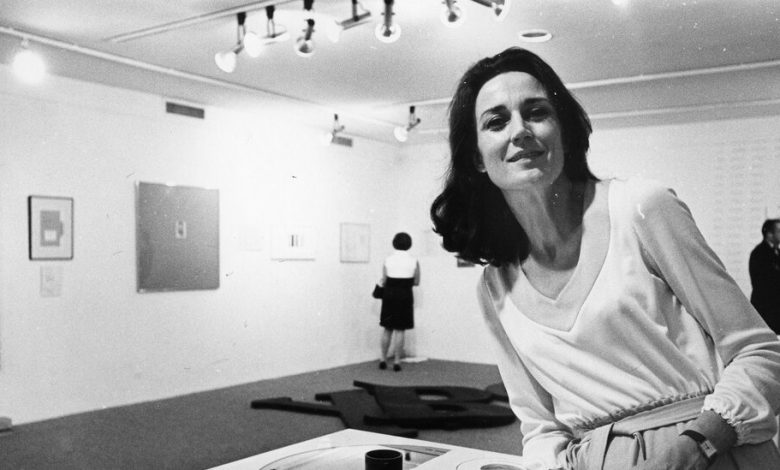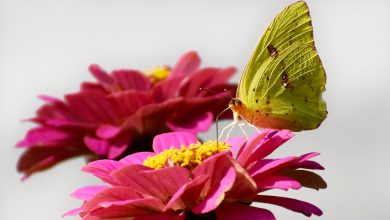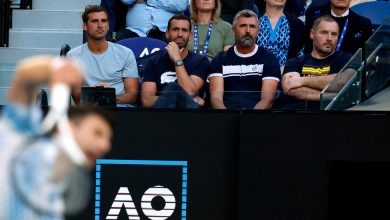Virginia Dwan, Behind-the-Scenes Force in the Art World, Dies at 90

Virginia Dwan, who through her galleries in Los Angeles and New York and her personal financial support helped fuel the explosion of artistic innovation of the 1960s and beyond, and who later enriched the collections of the National Gallery of Art and other institutions with extensive donations from her personal collection, died on Sept. 5 at her home in Santa Fe, N.M. She was 90.
Her daughter, Candace Dwan, said the cause was cancer.
Ms. Dwan was a granddaughter of John Dwan, a founder of the Minnesota Mining and Manufacturing Company, which became 3M, and was one of the heirs to that family fortune. Beginning in her 20s, she used her resources to exhibit and often support Robert Rauschenberg, Charles Ross, Carl Andre, Sol LeWitt, Michael Heizer and many others who were breaking new ground — sometimes literally — in the postwar years.
She opened her first gallery in 1959 in the Westwood section of Los Angeles, exhibiting examples of Nouveau Réalisme from France and giving Mr. Rauschenberg his initial Los Angeles exposure in 1962 when she showed his innovative “combine” works, hybrids that merged painting and three-dimensional objects.
In 1965 she opened a second gallery, in Manhattan.
“In New York, I really found my groove,” she said in a recording for the Columbia Center for Oral History Research in 2014.
She opened that gallery with an exhibition by Edward Kienholz, who was becoming known for his elaborate assemblages, but soon she had a reputation for championing Minimalists like Mr. LeWitt and Mr. Andre, as well as Conceptualism.
Then, in 1968, she staged “Earthworks,” an exhibition celebrating art — that made use of the land, some of it gigantic. Her interest in that field extended to financing Land Art works like Mr. Heizer’s “Double Negative” (1969) in the Nevada desert and Robert Smithson’s “Spiral Jetty” (1970) in Utah.
For half a century she provided financial support to Mr. Ross, including for his ambitious “Star Axis” project in New Mexico, a huge outdoor observatory that he first conceived in the early 1970s and has been working on ever since.
“The wonderful thing about Virginia was that when she got involved in the art, she really got involved in it,” Mr. Ross said in a phone interview. She loved talking with artists about the ideas behind their work.
Michael Govan, director of the Los Angeles County Museum of Art, who had known her for years, said Ms. Dwan was at the heart of an explosive time in art and absorbed it all.
“Innovation was everywhere,” he said in a phone interview. “I think one of the things she did was put herself in the middle of things with a very open mind.”
She wasn’t a gallerist for long — the Los Angeles gallery closed in the late 1960s and the New York one in 1971 — but Mr. Ross said that in addition to Minimalism, genres like conceptual art and language art also took hold in her New York space.
“All started in her gallery,” he said. “That’s a pretty impressive list.”
Ms. Dwan acknowledged that she didn’t excel at the practical side of running a gallery and was ultimately overwhelmed by it.
“To the extent that art dealing is a profit-making business, she failed miserably,” Michael Kimmelman wrote in 2003 in The New York Times. “But art dealing, at its best, is not just a business, and what made her a poor businesswoman made her a legendary dealer, the grande dame of the avant-garde, or a part of it, briefly.”
If Ms. Dwan didn’t do well at selling art, she was quite good at acquiring it, and over the years she donated works to numerous museums, including the Weatherspoon Museum of Art at the University of North Carolina at Greensboro.
“Her first gift of art — a sound and installation piece by William Anastasi — was in 1968, and she continued to donate significant artworks by important 20th-century artists throughout the 1980s: Robert Rauschenberg, Louise Nevelson, Jim Dine, Larry Rivers, Philip Guston and others,” Elaine D. Gustafson, curator and head of collections and facilities there, said by email. “Her gifts have had a lasting impact, enabling the museum to support teaching and learning within the U.N.C. Greensboro community and beyond.”
Many of these gifts were made with little fanfare, but one generated headlines throughout the art world: her 2013 pledge of some 250 works to the National Gallery of Art in Washington.
In 2016 the National Gallery organized an exhibition in her honor, “Los Angeles to New York: Dwan Gallery, 1959-1971,” which also traveled to Mr. Govan’s museum. That exhibition was a testament to her ability to spot worthy art and trends, something that Mr. Govan said was aided by her eagerness to listen to artists and their ideas.
“She had an ear as well as eyes,” he said.
Virginia Ann Dwan was born on Oct. 18, 1931, in Minneapolis to Charles and Laura (Israelson) Dwan. Growing up, she wasn’t particularly immersed in art — “My mother had very good taste,” she said in the oral history recording for Columbia University, “but it didn’t extend to paintings” — yet became interested in it when she visited the Walker Art Center in Minneapolis when she was a teenager. There, she was struck by the works of Joseph Stella and John Marin.
She studied art briefly at U.C.L.A. but left when she and her first husband, Paul Henry Fischer, had a child, Candace Dwan. The marriage soon ended in divorce, as did a second marriage, to Vadim Kondratief, but not before Mr. Kondratief urged her to follow through on her oft-stated desire to open a gallery.
Less encouraging was Frank Perls, a noted dealer who had a gallery that Ms. Dwan would sometimes mind for him. One day she talked with him about her own hopes.
“I said, ‘Well, I’d like to have a gallery myself,’” she recalled in the oral history. “‘I really want a gallery.’ And he said, ‘Oh, how much money would you like to lose?’”
“And of course,” she added, “that was the way it turned out — that breaking even was quite difficult, let alone making any profit, because I was showing the art I believed in and I loved, and it wasn’t necessarily salable.”
If Ms. Dwan’s galleries weren’t a financial success, they were epicenters of artistic activity, places where artists met and a cross-pollination of ideas took place. Candace Dwan said that as a teenager she would often stop by the New York gallery after school.
“I’d go over there and find all the artists lined up on the couch talking,” she said. “It’s almost like a salon she had going there.”
Mr. Ross said that Ms. Dwan had so many artists in her fold that in 1967 when Mr. LeWitt suggested that he go see her, he almost got turned away.
“She said, ‘I can’t even look at anymore; my head is full,’” Mr. Ross, who was working in prisms at the time, recalled. “And I said, ‘Well, I make big prisms.’ And she said, ‘Can I come down tomorrow?’”
That insatiable curiosity continued to drive her for decades, including fueling her interest in Land Art. In 1985 she made art-world news when she donated “Double Negative,” Mr. Heizer’s land sculpture, which consists of two long, deep trenches, to the Museum of Contemporary Art in Los Angeles. She explained the appeal of that work in a 1985 interview with The Times.
“It implies that art isn’t just something portable to embellish a museum,” she said. “‘Double Negative’ is something that calls attention to the world. It calls our attention to the West and to the earth, both as a material and as a planet.”
In addition to her daughter, Ms. Dwan is survived by two grandchildren and two great-grandchildren.





